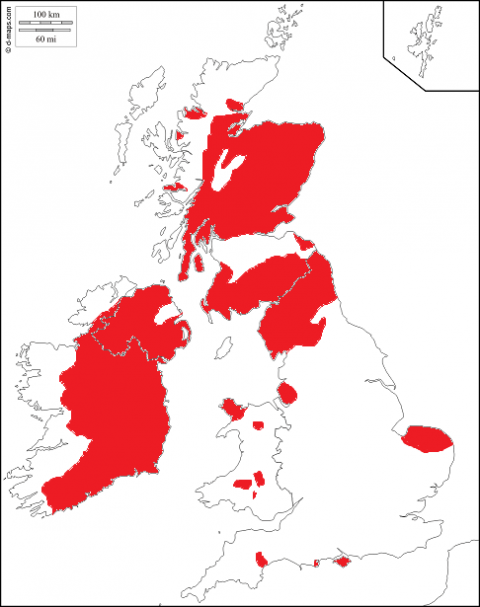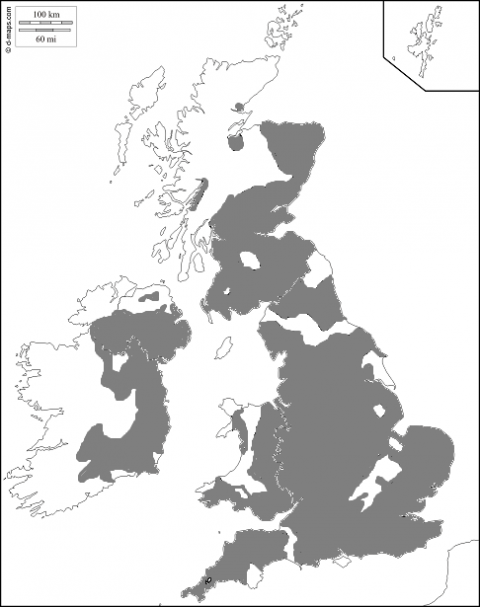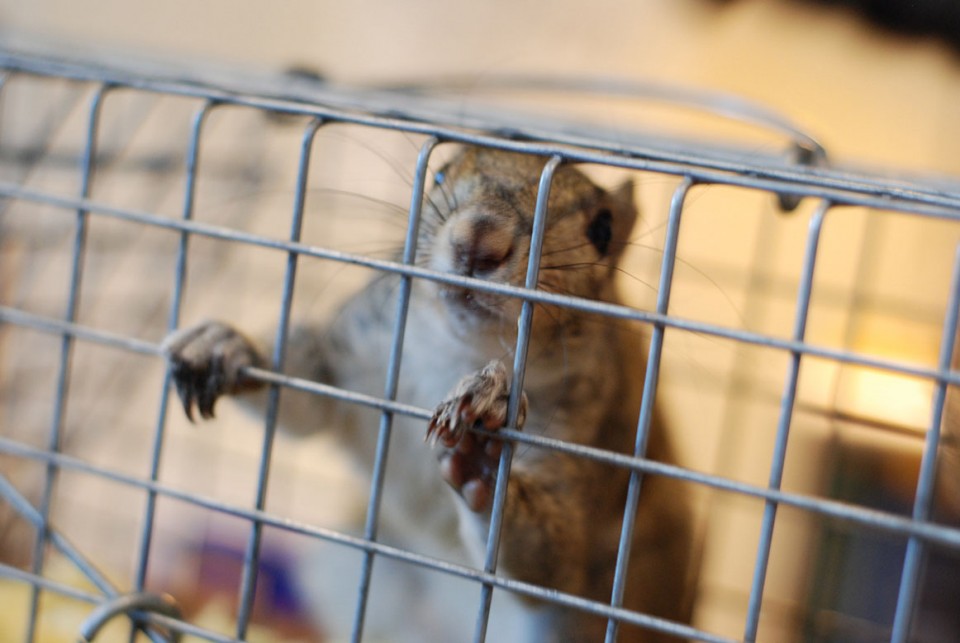Squirrel Distribution & Habitat
Distribution
Globally, squirrels are found on every continent except Australia and Antarctica. (The so-called "Australian squirrels" are actually petaurids, i.e. marsupials of the Petauridae family, and thus not true squirrels, although there is evidence suggesting that some true squirrels may have started to colonize Australia.)
The Red squirrel

Reds are found throughout Europe and Asia, about 70oN to 30oN, from Ireland in the west to Japan in the east. No specimens are known from Iceland or the Mediterranean Islands. Within the UK, Red squirrels used to be widespread across the country, found in almost all parts of Britain except western Northern Ireland, the far north of Scotland and a narrow central strip of England. Today, they are still reasonably widespread throughout much of southern and eastern Scotland and central and eastern Ireland, although the results of the 2007 Irish Squirrel Survey suggested the range of the Red squirrel in Ireland had declined by about 30% since 1997. The 2012 update to the survey, however, reported some more encouraging news:
"Red squirrels are still widespread throughout the island of Ireland, and records have increased both numerically and geographically since the last squirrel survey in 2007. There are particularly high numbers of sightings of red squirrels in the northwest, in the south, in Clare and Galway and in Wicklow."
Genetic work by Laura Finnegan at Trinity College and her colleagues has shown that Reds were introduced to Ireland from England, Scotland and parts of Europe by humans many times in the last 200 years, such that Ireland now contains a mixture of native and introduced lineages. The genetic mixing is now such that it's impossible to tell whether any squirrels survived the ice age in Ireland and recolonised by themselves, or whether squirrels recolonised Ireland after the ice retreated across a putative land bridge. Finnegan and her co-workers found that some of these introductions were made from southern England and their data suggest that the Irish population may thus contain lineages of Red squirrels that are now extinct in England, providing a suitable source for subsequent reintroductions.
Red squirrels seem to have benefitted from recent afforestation schemes, which have helped connect populations and expand their range. Genetic data by Marie Hale and colleagues published in 2001, for example, show a sudden increase in gene flow into Cumbria from Northumberland during the 1980s. The suggestion is that the maturing of the newly-planted Kielder Forest linked the existing woodland fragments of southern Scotland and north Northumberland with those in eastern Cumbria along the Eden Valley, allowing squirrels to cross what had previously been a large area of open grass and moorland.
One Red squirrel "stronghold" in England is in the north, and English Nature estimates that somewhere in the region of 85% of England's Red squirrels live in Cumbria, Durham, Northumberland and North Lancashire. Even within this range the distribution is not uniform and the charity Red Squirrels Northern England estimate that about 60% of the English population are found within Kielder Forest in Northumberland. More isolated populations are dotted further south, including in Lancashire, Norfolk, on Brownsea Island in Dorset and the Isle of Wight off the Hampshire coast. The Wight population is probably England's second stronghold, consisting of about 3,300 animals, although recent genetic data from Bournemouth University suggest that the island's population is split into two genetically distinct populations, one in the east and the other in the west, with fragmented woodland in the centre of the island restricting geneflow. In late June 2018, a lady from the Isle of Wight reported seeing a Red squirrel on a road near Durdle Door in Dorset, but this has yet to be confirmed. The Cornwall Red Squirrel Project began a project reducing Greys around the Lizard and West Penwith in 2012 with a view to reintroducing the species in these areas and while no releases have yet been made, captive breeding populations have been established. Their distribution is patchy in Wales found primarily on Anglesey but with small populations in Powys and Dyfed.

Despite relatively large Red populations persisting across much of Europe, their future is considered by many conservationists to be uncertain since the introduction, during 1948, of Greys to Piedmont in Italy, where, according to Fiona Harvey's article in The Guardian in September 2012, the Red is now extinct. In a paper to the journal Biological Invasions in 2014, Sandro Bertolino and his team note that between 1970 and 2010 the Red squirrel was replaced by the Grey in 62% of their study site in north-western Italy, representing a loss in distribution of almost 1,700 sq-km (650 sq-mi) in four decades. Indeed, French and Swiss authorities recently requested that the European Commission put pressure on the Italian government to control their Grey squirrel population.
The Grey squirrel
Grey squirrels are native to the oak-hickory forests of eastern North America and their presence in Britain and Europe is a result of deliberate release from captive collections imported from various states, but particularly Maryland and Virginia. Interestingly, recent haplotype work by Rebecca Synott, currently at the South East Technological University in Ireland, and colleagues, suggests some of the British haplotypes they found were not documented in the US. The first verifiable record is from 1876, when Thomas Brocklehurst released a pair of Greys into Henbury Park near Macclesfield in Cheshire. Arguably, the most significant introduction, when considering their subsequent spread, were animals imported by a Mr G.S. Page of New Jersey that, according to Richard Fitter's 1938 London Naturalist article, were released into the parkland of Woburn Abbey in 1890. This population bred well and were the source of at least eight subsequent introductions across the UK. The first appearance in Wales was at Llandisilio Hall in Denbighshire during October 1828, but it is not known from where these squirrels originated, and Thomas George Walker, in his chapter on mammals in the Natural History of Anglesey, published in 1968, noted the species was recorded on Anglesey for the first time in 1966.

Today, Greys are found throughout England and Wales, although they are scarce in the area from the north Pennines to the Southern Uplands (ca. 56N to 54N). They're absent from Anglesey and Brownsea islands and, excluding the odd stowaway caught on a ferry from the mainland (the last instance in 2001), they're also absent from the Isle of Wight. The failure of Greys to colonise these areas, most of which are strongholds for Reds, is in no small part the result of comprehensive monitoring and culling programmes run by Red squirrel conservation groups. The first recorded release of Greys into Scotland was in 1892, when a pair were released in Argyll and Bute, and Scotland now has several established Grey squirrel populations, particularly in the southern half of the country, near Glasgow, Edinburgh and Perth, among other places.
Since its introduction to Castle Forbes in County Longford during 1911, the Grey squirrel spread along the east coast and had colonised all areas of Leinster, except Wicklow and Wexford, by 1997. They subsequently spread throughout much of the north, east and south of the country and are now found in central and southern Northern Ireland and throughout most of eastern Ireland, with the River Shannon marking the western extent of their range. The 2012 Irish Squirrel Survey recorded them in 26 of the 32 Irish counties. In a paper to the journal Biological Invasions during 2016 Emily Goldstein, Fidelma Butler and Colin Lawton presented the results of their computer model of Grey squirrel expansion in Ireland. The model predicts that, in the absence of control, the Grey squirrel range is predicted to expand to the south and southwest of Ireland, expanding into much of eastern Cork by 2022 and having reached Kerry and Limerick in the west by 2062.
Elsewhere in Europe, the Grey squirrel has become established in Italy. The first verifiable release was during 1948, when four (2 male and 2 female) that had apparently been a gift from the US ambassador escaped (or were deliberately released) into Stupinigi in Piedmont, a province of Turin in northwest Italy. Subsequent releases include five animals into a park at Villa Groppallo, Genoa Nervi on the Italian Riviera during 1966, and three pairs into an urban part at Trecate, a province of Novara in northwest Italy. A survey in 1996 estimated the Italian Grey squirrel population, the entirety of which appeared to be in the northwest provinces, at between 2,500-6,400 individuals.
In 2008, Sandro Bertolino and colleague used computer models to predict how the Grey might spread in Europe and, in their paper to the journal Biological Conservation, they present a "best case" scenario in which Greys reached the Western Alps between 2026 and 2036, France between 2066 and 2071, and Switzerland between 2051 and 2066. It seems that the researchers' "worse case" scenario -- which predicted them reaching the Western Alps by 2015, France by 2026, and Switzerland between 2031 and 2041 -- may have been more accurate. In 2015, Greys had almost reached the northern border of Italy, and many biologists think a "march across the Alps" is not far away. Indeed, French and Swiss authorities recently requested that the European Commission put pressure on the Italian government to control their Grey squirrel population.

Greys have also been translocated within North America into British Columbia and Canada, as well as having been introduced to South Africa and Australia, the latter population being successfully eradicated.
Habitat
Both Reds and Greys are typically forest dwellers, although both can be found in parkland and gardens. Greys are much more at home in city parks and gardens than Reds and will more readily take advantage of human food waste. In their 2006 Advocates for Animals report, Stephen Harris, Carl Soulsbury and Graziella Iossa note that Norway spruce, Douglas fir, European larch and Japanese larch being particularly good habitat for Reds, while Greys prefer broadleaved woodland and Norway spruce. Reds will inhabit broadleaved woodland, particularly hazel, in the absence of Greys, who readily out-compete them in such habitat. Sitka spruce and Scots pine are given as poor habitat for both species.
In their article to the Spring 2016 issue of Westmorland Red Squirrels Newsletter, Peter Lurz, Craig Shuttleworth and John Gurnell note that Sitka spruce doesn't provide food all year around and, as such, can support only low densities of Reds, albeit that this species is apparently "excellent for dreys". Bird and wild cherry, lodgepole pine Serbian spruce, yew and wych elm are considered beneficial to Reds, while species that produce large seeds (e.g. beech, hazel, horse chestnut, walnut and particularly oak) are generally beneficial to Greys. The biologists list alder, aspen, birch, box, cypress, field maple, hawthorn, holly, juniper, poplars, western hemlock, western red cedar and willows as "neutral" species, being small seeded species that will be eaten by Reds but do not encourage Greys.